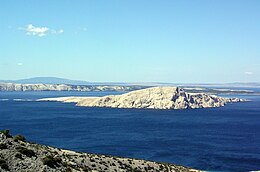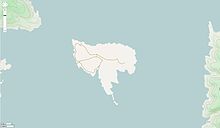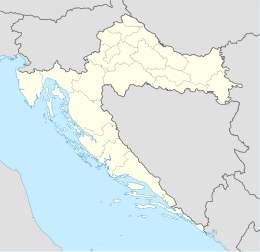Goli Otok
 Goli Otok seen from the mainland | |
 | |
| Etymology | Croatian: goli otok, lit. 'barren island' |
|---|---|
| Geography | |
| Adjacent to | Adriatic Sea |
| Area | 4.54 km2 (1.75 sq mi)[1] |
| Administration | |
Croatia | |
| County | Primorje-Gorski Kotar |
| Demographics | |
| Population | 0 |
Goli Otok (pronounced [ɡôliː ǒtok]; lit. 'Barren Island'; Italian: Isola Calva) is a barren, uninhabited island that was the site of a political prison which was in use when Croatia was part of Yugoslavia.[2][3] The prison was in operation between 1949 and 1989.[4]
The island is located in the northern Adriatic Sea just off the coast of Primorje-Gorski Kotar County, Croatia with an area of approximately 4.5 square kilometers (1.7 sq mi). Exposed to strong bora winds, particularly in the winter, the island's surface is almost completely devoid of vegetation, giving Goli Otok (literally, 'barren island' in Croatian) its name. It is also known as the "Croatian Alcatraz" because of its island location and high security.[5]
Prison
[edit]| Goli Otok labor camp and prison | |
|---|---|
| labor camp | |
 The abandoned prison on Goli Otok | |
| Location | Goli Otok, Croatia |
| Operated by | |
| Operational | 1949 to 1956 (for political prisoners) and until December 30, 1988 as a normal prison |
| Inmates | Stalinists, anti-Titoist dissidents and anti-communists |
| Notable inmates | See List of notable prisoners section |
Despite having long been an occasional grazing ground for local shepherds' flocks, the barren island was apparently never permanently settled other than by the prisoners during the 20th century.[6] Throughout World War I, Austria-Hungary sent Russian prisoners of war from the Eastern Front to Goli Otok.[6]
In 1949, the entire island was officially made into a high-security, top secret prison and labor camp run by the authorities of the People's Federal Republic of Yugoslavia,[6] together with the nearby Sveti Grgur island, which held a similar camp for female prisoners. Until 1956, following the Tito–Stalin split and throughout the Informbiro period, it was used to incarcerate political prisoners. These included known and alleged Stalinists, but also other Communist Party of Yugoslavia members or even non-party citizens accused of exhibiting sympathy or leanings towards the Soviet Union.
Many anti-communists (Serbian, Croatian, Macedonian, Albanian and other nationalists etc.) were also incarcerated on Goli Otok. Non-political prisoners were also sent to the island to serve out simple criminal sentences[7][8] and some of them were sentenced to death. A total of approximately 16,000[9][10] political prisoners served there, of which between 400[11] and 600[5][12] died on the island. Other sources, largely based on various individual statements, claim almost 4,000 prisoners died in the camp.[13][14][15]
The prison inmates were forced to labor (in a stone quarry, pottery and joinery), without regard to the weather conditions: in the summer the temperature would rise as high as 40 °C (104 °F), while in the winter they were subjected to the chilling bora wind and freezing temperatures.[16] The prison was entirely inmate-run, and its hierarchical system forced the convicts into beating, humiliating, denouncing and shunning each other. Those who cooperated could hope to rise up the hierarchy and receive better treatment.[17][18]
After Yugoslavia normalized relations with the Soviet Union, Goli Otok prison passed to the provincial jurisdiction of the People's Republic of Croatia (as opposed to the Yugoslav federal authorities). Regardless, the prison remained a taboo topic in Yugoslavia until the early 1980s.[19] Antonije Isaković wrote the novel Tren (Moment) about the prison in 1979, waiting until after Josip Broz Tito's death in 1980 to release it. The book became an instant bestseller.[20] The prison was shut down on 30 December 1988[21] and completely abandoned in 1989.[6] Since then it has been left to ruin.[5] It has since become a tourist attraction and is populated by shepherds from Rab. Former Croatian prisoners are organized into the Association of Former Political Prisoners of Goli Otok.[22] In Serbia, they are organized into the Society of Goli Otok.[23]
Notable prisoners
[edit]
- Šaban Bajramović, Serbian Romani musician[24]
- Panko Brashnarov, Macedonian politician[25]
- Vlado Dapčević, Yugoslav Montenegrin communist revolutionary and partisan[26]
- Adem Demaçi, Kosovo Albanian politician and author[27]
- Teki Dervishi, Albanian writer[27]
- Vlado Dijak, Yugoslav Bosnian Serb writer and partisan[28]
- Nikola Kljusev, former Prime Minister of Macedonia[29]
- Tine Logar, Slovenian linguist[30]
- Venko Markovski, Macedonian writer[6]
- Dragoljub Mićunović, Serbian partisan, sociologist, and politician[31]
- Dragoslav Mihailović, Serbian writer[32]
- Alfred Pal, Croatian painter and graphic designer[33]
- Dobroslav Paraga, Croatian politician[21]
- Aleksandar Popović, Serbian writer[34]
- Igor Torkar, Slovenian writer[6]
- Vlasta Velisavljević, Serbian actor[35]
- Ante Zemljar, Croatian partisan and writer[36]
- Savo Zlatić, Croatian physician and politician[37]
- Vitomil Zupan, Slovenian writer[6]
Literature
[edit]

- 1981: Noč do jutra ('Night till Morning Comes') ‒ novel by Slovenian author Branko Hofman.[6]
- 1981: Herezia e Dervish Mallutes – allegorical novel by Kosovar author Teki Dervishi.
- 1982: Tren 2 – novel by Antonije Isaković.
- 1984: Umiranje na obroke ('Dying by Installments') ‒ autobiographical book by Slovenian author Igor Torkar, about Goli Otok prison conditions.
- 1984: Goli Otok: The Island of Death ‒ non-fiction book by Bulgarian-Macedonian author Venko Markovski, detailing a history of Goli Otok prison.
- 1990: Goli Otok by Dragoslav Mihailović.
- 1993: Lov na stenice ('Hunting for Bedbugs') by Dragoslav Mihailović.
- 1996: Goli Otok: stratište duha ('Goli Otok: Gallows of the Soul') ‒ non-fiction book by Croatian author Mihovil Horvat, containing the events of his arrest and imprisonment during Informbiro period.
- 1997: Goli Otok: Italiani nel Gulag di Tito ('Goli Otok: Italians in Tito's Gulag') ‒ historical report by Italian-Croatian author Giacomo Scotti.[14]
- 1997: Zlotvori ('Evildoers') – novel by Dragoslav Mihailović.
- 1997: Tito's Hawaii ‒ novel by author using the pen-name Rade Panic (name taken from a political victim of the same name whose wife was interred on the island; not his actual name).[38]
- 2005: Razglednica s ljetovanja ('A Postcard From Summer Vacation') ‒ autobiographical short novel by the Croatian author Dubravka Ugrešić; published in the Belgrade literary review REČ časopis za književnost i kulturu, i društvena pitanja, br. 74/20, 2006, and in the book Nikog nema doma, ed. devedeset stupnjeva, Zagreb 2005. Italian translation Cartolina Estiva by Luka Zanoni Osservatorio Balcani e Caucaso, 2008.[39]
- 2010: Island of the World - novel by Canadian author Michael D. O'Brien.
- 2019: Life Plays with Me (Published in North America as More Than I Love My Life) - novel by Israeli writer David Grossman. One of the main characters, Vera, was interned as a political prisoner in Goli Otok before immigrating to Israel.

- 2023: The Secret of Bald Island - non-fiction book by Claudia Sonia Colussi Corte, describing her father's (Cherubino Colussi Corte) return to Mali Lošinj, Yugoslavia, as part of the Italian Controesodo, his arrest on suspicion of being a Stalinist, and his imprisonment on Goli Otok during the Informbiro period.[40]
Film and television
[edit]- 1996: The Seventh Chronicle (Sedma kronika) – Croatian feature film about a Goli Otok inmate who escapes by swimming to the island of Rab, based on a novel by Grgo Gamulin[41]
- 2002: Eva ‒ documentary film told in German, Hebrew and English recounting the experiences of Eva Panić-Nahir, a former prisoner of the island; produced/directed by Avner Faingulernt[42]
- 2009: Strahota - Die Geschichte der Gefängnisinsel Goli Otok ‒ German-language documentary film with 8 former prisoners; produced/directed by Reinhard Grabher[43]
- 2012: Goli Otok ‒ documentary film directed by Darko Bavoljak[44]
- 2013: Lost Survivors ‒ Travel Channel reality TV survival series episode entitled "Prison Island"[45]
- 2014: Goli – documentary film directed by Tiha K. Gudac[46]
- 2014: In the Name of the People ‒ exhibition in Belgrade; with an alphabetical list of 16,500 names of people who were jailed at the Goli Otok available for online search on their website Archived 2024-04-17 at the Wayback Machine
- 2019: Mysteries of the Abandoned ‒ Season 4 Episode 9 "Haunting on Plague Island"[47]
References
[edit]- ^ Duplančić Leder, Tea; Ujević, Tin; Čala, Mendi (June 2004). "Coastline lengths and areas of islands in the Croatian part of the Adriatic Sea determined from the topographic maps at the scale of 1 : 25 000" (PDF). Geoadria. 9 (1). Zadar: 5–32. doi:10.15291/geoadria.127. Retrieved 2019-12-21.
- ^ Žižek, Slavoj (2009). The Parallax View. Cambridge, MA: MIT Press. p. 288.
Goli otok ... a notorious Communist concentration camp
- ^ Almond, Mark (1994). Europe's Backyard War: The War in the Balkans. London: Mandarin. p. 158.
The island concentration camp of Goli Otok ...
- ^ Dežman, Jože (2006). The Making of Slovenia. Ljubljana: National Museum of Contemporary History. p. 140.
the concentration camp on Goli otok established in 1949
- ^ a b c Gibbens, Sarah (29 August 2017). "See the Haunting Ruins of a Prison Once Known as a 'Living Hell'". National Geographic. Archived from the original on September 1, 2017. Retrieved 5 September 2017.
- ^ a b c d e f g h Segel 2012, pp. 323–325.
- ^ "Donja Klada » Goli otok". Archived from the original on 25 November 2017. Retrieved 7 November 2017.
- ^ "Višestruki ubojica s Golog otoka opet ubio". Jutarnji list. 31 May 2006. Retrieved 27 February 2017.
- ^ Central Intelligence Agency (20 November 1970). "Yugoslavia: The Outworn Structure" (PDF). p. 3.
- ^ Previšić 2015, p. 192.
- ^ Previšić 2015, p. 190.
- ^ "Srbija nudi odštetu zatvorenicima na Golom otoku - devet dolara po danu". Slobodna Dalmacija (in Croatian). 25 July 2012. Retrieved 2 September 2014.
- ^ Goli Otok, AestOvest, Osservatorio Balcani e Caucaso 2008
- ^ a b "scotti". www.comune.bologna.it. Retrieved 7 November 2017.[publisher missing]
- ^ Previšić 2015, pp. 175–177.
- ^ Previšić 2014, p. 234.
- ^ Vežić, Goran. "Goli otok - zloglasna Titova kaznionica". dw.com (in Croatian). Deutsche Welle. Retrieved 30 July 2018.
- ^ "'Nikada nećemo saznati čija je konkretno ideja o osnivanju logora na Golom otoku'".
- ^ Previšić 2015, p. 174.
- ^ Daniel J. Goulding, Liberated cinema: the Yugoslav experience, 1945-2001, Indiana University Press, 2002. (p. 159)
- ^ a b "Na Golom otoku žalio sam što nisam kriminalac". Večernji list (in Croatian). 1 January 2005. Retrieved 27 February 2017.
- ^ "Slobodna Dalmacija". arhiv.slobodnadalmacija.hr. Archived from the original on 2012-10-17. Retrieved 7 November 2017.
- ^ "Spomen žrtvama Golog otoka na Adi - Glas javnosti". www.glas-javnosti.rs. 3 December 2007. Retrieved 7 November 2017.
- ^ "BIO JE NEPONOVLJIV / Odrastao u bijedi, zbog djevojke pobjegao iz vojske pa završio na Golom otoku. Pio je i trošio kao da nema sutra, a umro u bijedi – 100posto.hr". Archived from the original on 2019-04-16. Retrieved 2019-04-16.
- ^ Goli Otok: The Island of Death: a Diary in Letters, Venko Markovski, Social Science Monographs, Boulder, 1984, ISBN 0880330554, р. 42.
- ^ "Odiseja Vlada Dapčevića". NOVOSTI (in Serbian). Retrieved 2022-08-26.
- ^ a b "Croatia ponders fate of 'Tito's Guantanamo'". 2014. Retrieved 14 February 2019.
- ^ Magazin, X. X. Z. (2017-03-14). "Ambasador boema - XXZ Portal". www.xxzmagazin.com (in Serbian). Archived from the original on 2022-10-05. Retrieved 2022-08-26.
- ^ "Никола Кљусев". Makedonska nacija (in Macedonian). 6 April 2011. Retrieved 7 November 2017.
- ^ "LINGUIST List 14.1: Obituary: Tine Logar". The LINGUIST List. 2003-01-05. Retrieved 2022-08-26.
- ^ Mikuš, Marek (2018). Frontiers of civil society : government and hegemony in Serbia. New York, NY. ISBN 978-1-78533-891-5. OCLC 1020300288.
{{cite book}}: CS1 maint: location missing publisher (link) - ^ Segel 2012, p. 384.
- ^ Čadež, Tomislav. "Alfred Pal: Preživio holokaust, dvaput bio na Golom otoku, a onda radio najljepše hrvatske knjige". Jutarnji list (in Croatian). Archived from the original on 2011-08-14. Retrieved 2012-07-03.
- ^ ""Pitomac" Golog otoka". www.novosti.rs (in Serbian (Latin script)). Retrieved 2019-08-15.
- ^ "NEVJEROJATAN ŽIVOT LEGENDE / Pobjegao je iz nacističkog logora, a robijao je na Golom otoku. Zbog toga ga se žena odrekla i nikad joj nije oprostio, a ni nakon 90. Ne želi u mirovinu – 100posto.hr" (in Croatian). Archived from the original on 2019-07-30. Retrieved 2019-07-30.
- ^ "Zemljar, Ante | Hrvatska enciklopedija" (in Croatian).
- ^ Stipančević, Mario (April 2004). "Razgovor s dr. Savom Zlatićem" [Interview with Savo Zlatić, M.D.] (PDF). Arhivski vjesnik (in Croatian). 47 (47). Zagreb: Croatian State Archives: 119–132. Retrieved 21 April 2014.
- ^ "Tito's Hawaii, a novel about Goli Otok". www.oocities.org. Retrieved 7 November 2017.
- ^ Ugrešić, Dubravka (2008). "Cartolina estiva" (PDF). AestOvest. Osservatorio Balcani e Caucaso.
- ^ www
.academia .edu /103126672 /AO _4 _Claudia _Sonia _Colussi _Corte _The _Secret _of _Bald _Island _trans _Konrad _Eisenbichler _ - ^ "Baza HR kinematografije".
- ^ "Eva". IMDb.
- ^ Peherstorfer, Markus (5 May 2009). "Die vergessene Hölle der Adria". Der Standard (in German). Retrieved 30 July 2018.
- ^ "Goli otok". havc.hr (in Croatian). Retrieved 30 July 2018.
- ^ "Travel Channel's Lost Survivors episode, "Prison Island" partly filmed on Croati's Goli otok island". travelchannel.com. Archived from the original on 26 December 2013. Retrieved 17 January 2014.
- ^ Godeč, Željka (2 September 2014). "Moja potraga za istinom o djedovom zatočeništvu na Golom otoku". Jutarnji list (in Croatian). Retrieved 30 July 2018.
- ^ Mysteries of the Abandoned (TV Series 2017– ) - IMDb, retrieved 2021-12-02
Sources
[edit]- Previšić, Martin (2014). Povijest informbiroovskog logora na Golom otoku 1949. –1956 [History of the Goli Otok Cominformist Prison Camp 1949. – 1956.] (PDF) (in Croatian). Faculty of Humanities and Social Sciences, University of Zagreb. Retrieved 30 July 2018.
- Previšić, Martin (February 2015). "Broj kažnjenika na Golom otoku i drugim logorima za informbirovce u vrijeme sukoba sa SSSR-om (1948.-1956.)" [The Number of Convicts on Goli Otok and other Internment Camps during the Informbiro period (1948 – 1956)] (PDF). Historijski zbornik (in Croatian). 66 (1): 173–193. Retrieved 27 July 2018.
- Segel, Harold B., ed. (2012). The Walls Behind the Curtain: East European Prison Literature, 1945-1990. University of Pittsburgh Press. ISBN 9780822978022.
Further reading
[edit]- Ekohistorijski aspekti proučavanja logora na Golom otoku 1949.-1956.
- https://www.lopar.com/hrv/turisticka_ponuda/izleti/goli_otok.php Archived 2019-06-08 at the Wayback Machine
- Antić, Ana (1 September 2016). "The Pedagogy of Workers' Self-Management: Terror, Therapy, and Reform Communism in Yugoslavia after the Tito-Stalin Split". Journal of Social History. 50 (1): 179–203. doi:10.1093/jsh/shw013. hdl:10871/33111.
- Previšić, Martin (2019). Povijest Golog otoka (in Croatian). Fraktura. ISBN 978-953266988-6.
External links
[edit]- www.goli-otok.hr
- www.goli-otok.com
- Comparative criminology | Europe - Yugoslavia
- Goli Otok: Hell in the Adriatic is the true story of Josip Zoretic's tragic experience and survival as a political prisoner of the former Yugoslavia's most notorious prison, Goli Otok, and the circumstances that led to his imprisonment [1]


